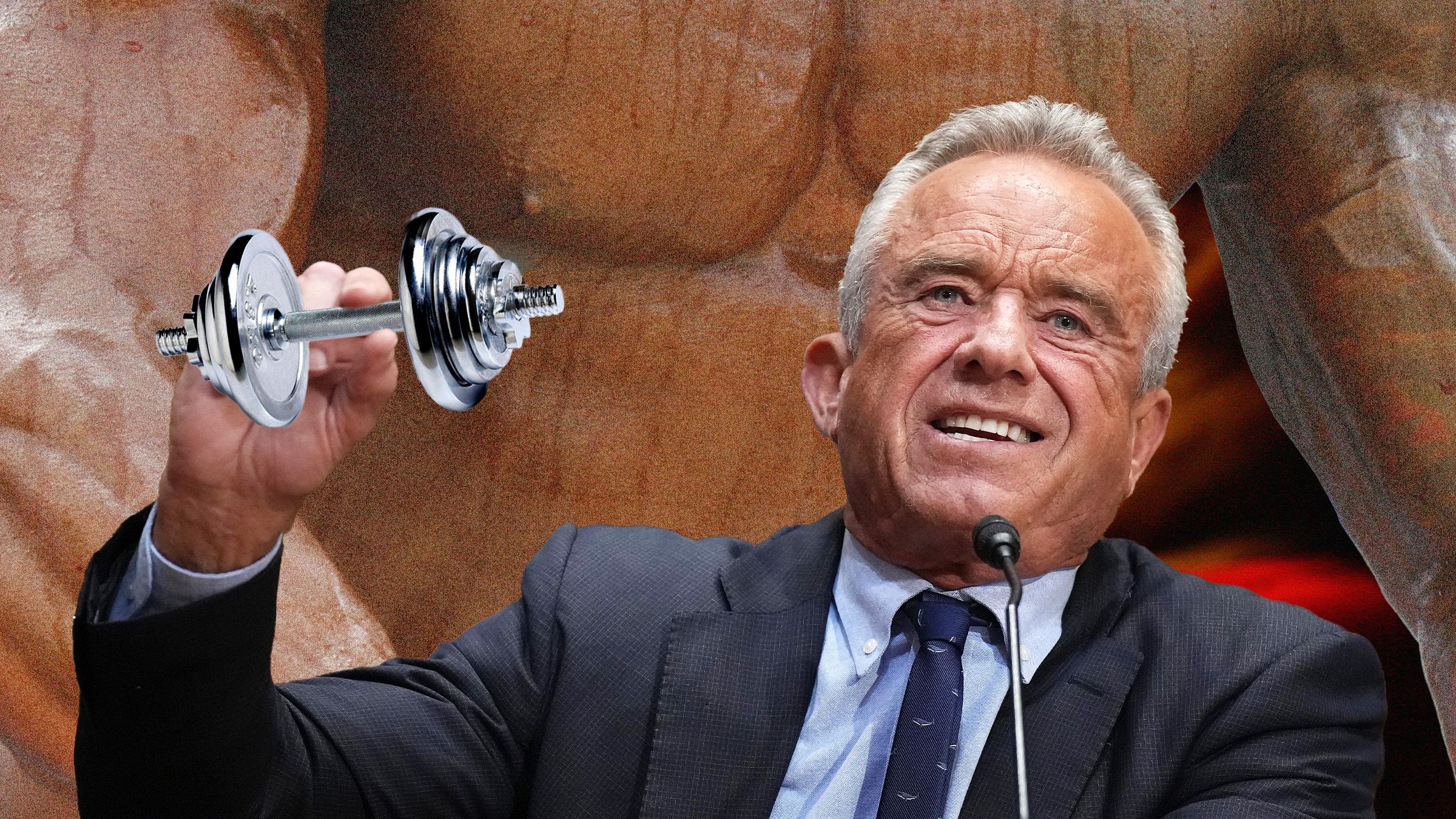Last week, “Secretary of War” Pete Hegseth called America’s troops fat. Every “warrior,” he said, will now be required to train every duty day and pass fitness tests twice a year. “Frankly, it’s tiring to look out at combat formations … and see fat troops. Likewise it’s completely unacceptable to see fat generals and admirals in the halls of the Pentagon.”
Equating physical appearance with battle-ready fortitude has become a consistent talking point for Hegseth and other Republicans in his orbit. In August, Hegseth and US health secretary Robert F. Kennedy Jr. launched the “Pete and Bobby Challenge” across their social media feeds, completing a workout of 100 pushups and 50 pull-ups, with the goal of finishing in under five minutes. (Within hours of its publication, left-wing accounts began making fun of Kennedy’s pull-up form and questioning his decision to wear denim while exercising.)
After the young male vote flipped toward Trump by almost 30 points in the last election, the fight for their attention has taken center stage in the US political culture war. Both parties are vying for the male half of the most fitness-obsessed generation in recent memory.
Though there is nothing inherently right-wing about lifting weights, fitness influencers have been at the forefront of the rightward shift of young men in recent years; exercise content represents a key bloc of the so-called manosphere. However, a small but rapidly growing subset of progressive gym bros are moving into the online fitness space, and influential figures on the left are taking notice.
Colin Davis, a 24-year-old from North Carolina, is one of those men. In a series of videos shared to TikTok and Instagram, Davis flexes under dim lighting that accentuates his massive biceps and showcases dumbbell bench presses to heavy metal music. He also posts about his leftist beliefs.
“You don’t need a side hustle, you need a union,” Davis captions one video that has almost 60,000 likes. In a TikTok post that has been liked over 187,000 times, he discusses the legacy of Martin Luther King Jr. and the value of political protest, while leaning on a squat rack
Davis first went viral in April when he published a video of himself seated in a lawn chair in the middle of the woods, ridiculing the “warrior” culture that has grown to dominate much of the male-oriented fitness space. “You are not a warrior, you are not a protector, you are not defending your homeland. You are a guy that lifts weights a couple times a week and maybe goes for a run,” he says, staring into the camera deadpan.
Though the aesthetic similarities can be undeniable, Davis’ content is a stark departure from the deluge of “trad” fitness that inundates many young men’s Instagram and TikTok feeds. Those often include compilation videos of men flexing their muscles, cut between clips that ridicule partying women, body-positivity influencers, and gay men. “Embrace Masculinity,” one such video emblazons across the center of the screen.
A stereotypical image of masculinity has been used by many on the far right for financial gain for years, with influencers like Andrew Tate, who has been charged with human trafficking in the UK, capitalizing off of weightlifting, combat sports, and fitness.
That trend became even more pronounced when Covid-19 hit. The lockdowns became a pressure cooker for some men, with gyms suddenly shuttered due to pandemic restrictions and calls to reopen them becoming heavily politicized. Social media has placed a premium on appearance, as testosterone replacement therapy and other performance-enhancing drugs soared in popularity, as did techniques dedicated to cultivating masculine jawlines (a process known as “mewing”). Active Clubs, a global network of over 150 mixed martial arts clubs designed to promote far-right networking, also proliferated during the pandemic, using fitness to connect and provide community to disenfranchised men.
It was this deluge of right-wing content that prompted Davis to make his first leftist video, he says. It resonated, taking his Instagram account from around 800 followers to over 50,000.
“ Almost all of the DM’s I’ve received have been from guys that lift weights that are almost like closeted leftists, where they’re like … I love hiking and I love fighting and I love lifting weights and I like beer and hamburgers, but I also want people to have fucking health care,” he tells WIRED. “I want more people to feel like they have a spot in the gym than just like straight white guys that go ‘rah, rah, boo, fuck you.’”
Some are getting offered a lot of money to offer similar perspectives.
Two left-leaning fitness influencers tell WIRED that they have signed five-figure contracts to create online content, in a deal brokered by a prominent Democratic operative. Both want to remain unnamed for professional reasons. WIRED has reviewed details of their contracts.
Sources familiar with the offers say they were pitched as part of an apparent pilot program designed to create a production system for left-wing content. They say the money, with each contract worth over $10,000, would come with limited stipulations, mainly asking the influencers to espouse “leftist values.” But that process has felt secretive and haphazard, they say. “It feels like no one that I’ve talked to has had a clear idea of what they really want or need. They’re just like, fuck, there’s a problem. Throw money at it, fix it,” a source tells WIRED.
As 2026 midterm elections approach, Democratic politicians are following the leads of their Republican counterparts and incorporating fitness into their online presence. Colorado representative Jason Crow posted a video of himself mocking Hegseth’s pull-up form on X, while Texas senatorial candidate (and former NFL linebacker) Colin Allred posted a video from inside a weight room demanding that the Trump administration release the Epstein Files. In Michigan, senatorial candidate Abdul El-Sayed posted a video of himself working out with prominent fitness influencer Mike Israetel. “Young men in particular are facing a crisis of purpose,” Ell-Sayed says in the video.
It is this exact crisis that has made the “manosphere” so resonant for many young men. Whether it is fitness, financial, or romantic, much of this style of content centers around themes of self-improvement, with many of the influencers in this space promising community through fitness. Other creators sell online courses that promise the financial freedom necessary for a better life, an opportunity to “escape the matrix,” as Tate often describes it.
“ The manosphere is a beautiful thing,” says Zack Telander, a fitness influencer with over 200,000 followers on Instagram. “It’s men teaching other men to be better, but then it can be one of the worst things ever when people utilize it as a fear-based platform or a fear-based home for men to kind of retreat to.” Telander has posted about fitness for years but began making content this year to counteract the extreme wings of the online fitness space.
Experts and fitness influencers who spoke to WIRED all agree that the right wing and the fitness content that circles it are capitalizing on legitimate concerns that men are experiencing around their roles in society. Young men are now much less likely to go to college than women; their median wages are down, while women’s median wages have grown, though the wage gap still favors men. Men are three times more likely to die deaths of despair; in 2023 the suicide rate among men was nearly four times higher than that of women.
While this kind of content has weaponized the real-world crisis that many young men are facing, the Democratic Party has largely failed to offer an alternative solution in recent years. As the Democrats’ base has shifted away from labor unions and the working class, many men have reported feeling “sidelined by progressive narratives that do not fully acknowledge their struggles or aspirations,” according to the SAM Project, which stands for Speaking with American Men, a $20 million Democratic project researching why the party has hemorrhaged young male voters in recent years.
According to the SAM Project’s initial study, men view the Democratic Party as “scripted, cautious, and uncertain of themselves” while their Republican counterparts are viewed as confident and unafraid to offend. Just 27 percent of men said they view the Democrats positively.
But it’s unclear if simply recognizing these fractures—or creating more weightlifting videos, even with a leftist bent—will be enough to contend with the online right’s well-oiled fitness machine.
With political violence at the forefront of culture war discussions, the stakes also feel much higher simply than winning votes.
In the days following right-wing activist Charlie Kirk’s death, Davis posted an Instagram reel addressed to Kirk’s followers.
“This war that we are throttling towards full speed is the war of our grandfather’s generation,” he says. “They’re planning for us to turn on each other and make this culture war a civil war. I am begging you, please, for the love of God, for the love of our neighbors … do not take the bait.”




